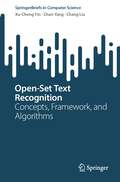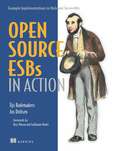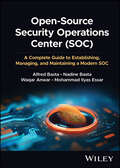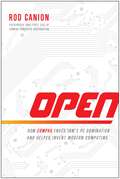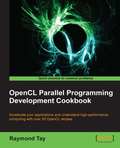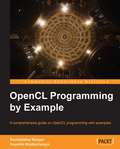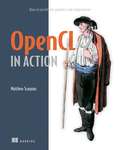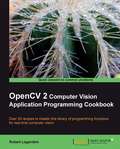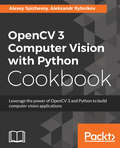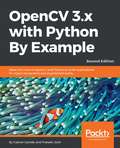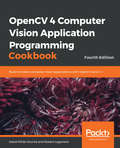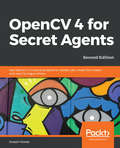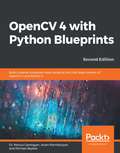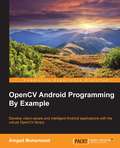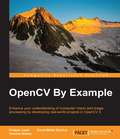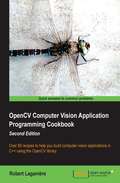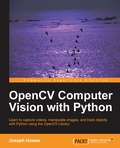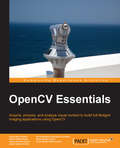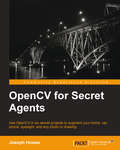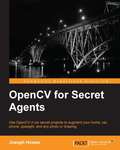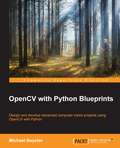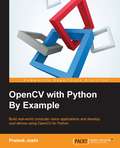- Table View
- List View
Open-Set Text Recognition: Concepts, Framework, and Algorithms (SpringerBriefs in Computer Science)
by Chang Liu Xu-Cheng Yin Chun YangIn real-world applications, new data, patterns, and categories that were not covered by the training data can frequently emerge, necessitating the capability to detect and adapt to novel characters incrementally. Researchers refer to these challenges as the Open-Set Text Recognition (OSTR) task, which has, in recent years, emerged as one of the prominent issues in the field of text recognition. This book begins by providing an introduction to the background of the OSTR task, covering essential aspects such as open-set identification and recognition, conventional OCR methods, and their applications. Subsequently, the concept and definition of the OSTR task are presented encompassing its objectives, use cases, performance metrics, datasets, and protocols. A general framework for OSTR is then detailed, composed of four key components: The Aligned Represented Space, the Label-to-Representation Mapping, the Sample-to-Representation Mapping, and the Open-set Predictor. In addition,possible implementations of each module within the framework are discussed. Following this, two specific open-set text recognition methods, OSOCR and OpenCCD, are introduced. The book concludes by delving into applications and future directions of Open-set text recognition tasks.This book presents a comprehensive overview of the open-set text recognition task, including concepts, framework, and algorithms. It is suitable for graduated students and young researchers who are majoring in pattern recognition and computer science, especially interdisciplinary research.
Open-Source ESBs in Action: Example Implementations in Mule and ServiceMix
by Jos Dirksen Tijs RademakersMost modern business systems include independent applications that exchange information with each other-a technique usually called enterprise integration. An architectural approach called the Enterprise Service Bus (ESB) offers developers a way to handle the messages between those independent applications without creating a lot of custom code. While commercial ESB solutions can be quite expensive to implement and maintain, a set of high-quality open source ESB tools offer the same functionality at a substantially lower cost.Open Source ESBs in Action shows you how to implement and use two open source ESB implementations: Mule and ServiceMix. The authors introduce you to these freely-available ESB tools and present practical examples of how to use them in real-world scenarios. You will learn how the various features of an ESB such as transformation, routing, security, connectivity and more can be implemented using Mule and ServiceMix. You will also learn how to solve common enterprise integration problems using a structured approach.Beyond simply learning how Mule and Service Mix work, you'll learn the core techniques of ESB implementation such as Process Choreography, or the implementation of complex business processes through an ESB, and Service Orchestration, or exposing a set of services as a single service. The book shows you the fundamentals of ESB-based event processing and Quality of Service concerns like security, reliable delivery, and transaction management.Working in integration projects is exciting, with new technologies and paradigms arriving every day. Open Source technologies like Mule and ServiceMix both offer lower-cost solutions and a higher degree of innovation than commercial ESB implementations. Open Source ESBs in Action will help you master ESB-driven integration techniques quickly and will provide you with knowledge you need to work effectively with Mule and ServiceMix. Purchase of the print book comes with an offer of a free PDF, ePub, and Kindle eBook from Manning. Also available is all code from the book.
Open-Source Security Operations Center (SOC): A Complete Guide to Establishing, Managing, and Maintaining a Modern SOC
by Alfred Basta Nadine Basta Waqar Anwar Mohammad Ilyas EssarA comprehensive and up-to-date exploration of implementing and managing a security operations center in an open-source environment In Open-Source Security Operations Center (SOC): A Complete Guide to Establishing, Managing, and Maintaining a Modern SOC, a team of veteran cybersecurity practitioners delivers a practical and hands-on discussion of how to set up and operate a security operations center (SOC) in a way that integrates and optimizes existing security procedures. You’ll explore how to implement and manage every relevant aspect of cybersecurity, from foundational infrastructure to consumer access points. In the book, the authors explain why industry standards have become necessary and how they have evolved – and will evolve – to support the growing cybersecurity demands in this space. Readers will also find: A modular design that facilitates use in a variety of classrooms and instructional settingsDetailed discussions of SOC tools used for threat prevention and detection, including vulnerability assessment, behavioral monitoring, and asset discoveryHands-on exercises, case studies, and end-of-chapter questions to enable learning and retention Perfect for cybersecurity practitioners and software engineers working in the industry, Open-Source Security Operations Center (SOC) will also prove invaluable to managers, executives, and directors who seek a better technical understanding of how to secure their networks and products.
Open: How Compaq Ended IBM's PC Domination and Helped Invent Modern Computing
by Rod CanionThe story of Compaq is well-known: Three ex-Texas Instruments managers founded Compaq with modest venture funding. Just four years later, Compaq was on the Fortune 500 list, and, two years after that, they had exceeded $1 billion in annual revenue. No company had ever achieved these milestones so rapidly. But few know the story behind the story. In 1982, when Compaq was founded, there was no software standardization, so every brand of personal computer required its own unique application software. Just eight years later, compatibility with the open PC standard had become ubiquitous, and it has continued to be for over two decades. This didn't happen by accident. Cofounder and then CEO Rod Canion and his team made a series of risky and daring decisions—often facing criticism and incredulity—that allowed the open PC standard marketplace to thrive and the incredible benefits of open computing to be realized. A never-before-published insider account of Compaq's extraordinary strategies and decisions, Open provides valuable lessons in leadership in times of crisis, management decision-making under the pressure of extraordinary growth, and the power of a unique, pervasive culture. Open tells the incredible story of Compaq's meteoric rise from humble beginnings to become the PC industry leader in just over a decade. Along the way, Compaq helped change the face of computing while establishing the foundation for today's world of tablets and smart phones.
OpenAM
by Indira ThangasamyThis book is a step-by-step tutorial stuffed with practical, real-world examples. It is designed in such a way that if you are already familiar with OpenAM, you can easily skip to a later chapter without missing a beat. You should be able to quickly grasp the basic elements of OpenAM before moving on to the more advanced features and functionality. If you are a security architect or a solution developer responsible for the design and development of web-based enterprise applications that need to provide authentication, authorization, and audit facilities along with SSO capabilities, then this book is for you. You do not require any prior knowledge of OpenAM to read this book. Familiarity with Java will be helpful, but is not essential.
OpenCL Parallel Programming Development Cookbook
by Raymond TayOpenCL Parallel Programming Development Cookbook will provide a set of advanced recipes that can be utilized to optimize existing code. This book is therefore ideal for experienced developers with a working knowledge of C/C++ and OpenCL.This book is intended for software developers who have often wondered what to do with that newly bought CPU or GPU they bought other than using it for playing computer games; this book is also for developers who have a working knowledge of C/C++ and who want to learn how to write parallel programs in OpenCL so that life isn't too boring.
OpenCL Programming by Example
by Koushik Bhattacharyya Ravishekhar BangerThis book follows an example-driven, simplified, and practical approach to using OpenCL for general purpose GPU programming.If you are a beginner in parallel programming and would like to quickly accelerate your algorithms using OpenCL, this book is perfect for you! You will find the diverse topics and case studies in this book interesting and informative. You will only require a good knowledge of C programming for this book, and an understanding of parallel implementations will be useful, but not necessary.
OpenCL in Action: How to accelerate graphics and computations
by Matthew ScarpinoSummaryOpenCL in Action is a thorough, hands-on presentation of OpenCL, with an eye toward showing developers how to build high-performance applications of their own. It begins by presenting the core concepts behind OpenCL, including vector computing, parallel programming, and multi-threaded operations, and then guides you step-by-step from simple data structures to complex functions.About the TechnologyWhatever system you have, it probably has more raw processing power than you're using. OpenCL is a high-performance programming language that maximizes computational power by executing on CPUs, graphics processors, and other number-crunching devices. It's perfect for speed-sensitive tasks like vector computing, matrix operations, and graphics acceleration.About this BookOpenCL in Action blends the theory of parallel computing with the practical reality of building high-performance applications using OpenCL. It first guides you through the fundamental data structures in an intuitive manner. Then, it explains techniques for high-speed sorting, image processing, matrix operations, and fast Fourier transform. The book concludes with a deep look at the all-important subject of graphics acceleration. Numerous challenging examples give you different ways to experiment with working code.A background in C or C++ is helpful, but no prior exposure to OpenCL is needed. Purchase of the print book comes with an offer of a free PDF, ePub, and Kindle eBook from Manning. Also available is all code from the book. What's InsideLearn OpenCL step by stepTons of annotated codeTested algorithms for maximum performance***********Table of ContentsPART 1 FOUNDATIONS OF OPENCL PROGRAMMINGIntroducing OpenCLHost programming: fundamental data structuresHost programming: data transfer and partitioningKernel programming: data types and device memoryKernel programming: operators and functionsImage processingEvents, profiling, and synchronizationDevelopment with C++ Development with Java and PythonGeneral coding principlesPART 2 CODING PRACTICAL ALGORITHMS IN OPENCLReduction and sortingMatrices and QR decompositionSparse matricesSignal processing and the fast Fourier transformPART 3 ACCELERATING OPENGL WITH OPENCLCombining OpenCL and OpenGLTextures and renderbuffers
OpenCV 2 Computer Vision Application Programming Cookbook
by Robert LaganiereThis is a cookbook that shows results obtained on real images with detailed explanations and the relevant screenshots. The recipes contain code accompanied with suitable explanations that will facilitate your learning. If you are a novice C++ programmer who wants to learn how to use the OpenCV library to build computer vision applications, then this cookbook is appropriate for you. It is also suitable for professional software developers wishing to be introduced to the concepts of computer vision programming. It can be used as a companion book in university-level computer vision courses. It constitutes an excellent reference for graduate students and researchers in image processing and computer vision. The book provides a good combination of basic to advanced recipes. Basic knowledge of C++ is required.
OpenCV 3 Blueprints
by Joseph Howse Steven Puttemans Quan Hua Utkarsh SinhaExpand your knowledge of computer vision by building amazing projects with OpenCV 3About This BookBuild computer vision projects to capture high-quality image data, detect and track objects, process the actions of humans or animals, and much moreDiscover practical and interesting innovations in computer vision while building atop a mature open-source library, OpenCV 3Familiarize yourself with multiple approaches and theories wherever critical decisions need to be madeWho This Book Is ForThis book is ideal for you if you aspire to build computer vision systems that are smarter, faster, more complex, and more practical than the competition. This is an advanced book intended for those who already have some experience in setting up an OpenCV development environment and building applications with OpenCV. You should be comfortable with computer vision concepts, object-oriented programming, graphics programming, IDEs, and the command line.What You Will LearnSelect and configure camera systems to see invisible light, fast motion, and distant objectsBuild a "camera trap", as used by nature photographers, and process photos to create beautiful effectsDevelop a facial expression recognition system with various feature extraction techniques and machine learning methodsBuild a panorama Android application using the OpenCV stitching module in C++ with NDK supportOptimize your object detection model, make it rotation invariant, and apply scene-specific constraints to make it faster and more robustCreate a person identification and registration system based on biometric properties of that person, such as their fingerprint, iris, and faceFuse data from videos and gyroscopes to stabilize videos shot from your mobile phone and create hyperlapse style videosIn DetailComputer vision is becoming accessible to a large audience of software developers who can leverage mature libraries such as OpenCV. However, as they move beyond their first experiments in computer vision, developers may struggle to ensure that their solutions are sufficiently well optimized, well trained, robust, and adaptive in real-world conditions. With sufficient knowledge of OpenCV, these developers will have enough confidence to go about creating projects in the field of computer vision.This book will help you tackle increasingly challenging computer vision problems that you may face in your careers. It makes use of OpenCV 3 to work around some interesting projects. Inside these pages, you will find practical and innovative approaches that are battle-tested in the authors' industry experience and research. Each chapter covers the theory and practice of multiple complementary approaches so that you will be able to choose wisely in your future projects. You will also gain insights into the architecture and algorithms that underpin OpenCV's functionality.We begin by taking a critical look at inputs in order to decide which kinds of light, cameras, lenses, and image formats are best suited to a given purpose. We proceed to consider the finer aspects of computational photography as we build an automated camera to assist nature photographers. You will gain a deep understanding of some of the most widely applicable and reliable techniques in object detection, feature selection, tracking, and even biometric recognition. We will also build Android projects in which we explore the complexities of camera motion: first in panoramic image stitching and then in video stabilization.By the end of the book, you will have a much richer understanding of imaging, motion, machine learning, and the architecture of computer vision libraries and applications!Style and approachThis book covers a combination of theory and practice. We examine blueprints for specific projects and discuss the principles behind these blueprints, in detail.
OpenCV 3 Computer Vision Application Programming Cookbook - Third Edition
by Robert LaganiereRecipes to help you build computer vision applications that make the most of the popular C++ library OpenCV 3 About This Book • Written to the latest, gold-standard specification of OpenCV 3 • Master OpenCV, the open source library of the computer vision community • Master fundamental concepts in computer vision and image processing • Learn about the important classes and functions of OpenCV with complete working examples applied to real images Who This Book Is For OpenCV 3 Computer Vision Application Programming Cookbook Third Edition is appropriate for novice C++ programmers who want to learn how to use the OpenCV library to build computer vision applications. It is also suitable for professional software developers who wish to be introduced to the concepts of computer vision programming. It can also be used as a companion book for university-level computer vision courses. It constitutes an excellent reference for graduate students and researchers in image processing and computer vision. What You Will Learn • Install and create a program using the OpenCV library • Process an image by manipulating its pixels • Analyze an image using histograms • Segment images into homogenous regions and extract meaningful objects • Apply image filters to enhance image content • Exploit the image geometry in order to relay different views of a pictured scene • Calibrate the camera from different image observations • Detect people and objects in images using machine learning techniques • Reconstruct a 3D scene from images In Detail Making your applications see has never been easier with OpenCV. With it, you can teach your robot how to follow your cat, write a program to correctly identify the members of One Direction, or even help you find the right colors for your redecoration. OpenCV 3 Computer Vision Application Programming Cookbook Third Edition provides a complete introduction to the OpenCV library and explains how to build your first computer vision program. You will be presented with a variety of computer vision algorithms and exposed to important concepts in image and video analysis that will enable you to build your own computer vision applications. This book helps you to get started with the library, and shows you how to install and deploy the OpenCV library to write effective computer vision applications following good programming practices. You will learn how to read and write images and manipulate their pixels. Different techniques for image enhancement and shape analysis will be presented. You will learn how to detect specific image features such as lines, circles or corners. You will be introduced to the concepts of mathematical morphology and image filtering. The most recent methods for image matching and object recognition are described, and you'll discover how to process video from files or cameras, as well as how to detect and track moving objects. Techniques to achieve camera calibration and perform multiple-view analysis will also be explained. Finally, you'll also get acquainted with recent approaches in machine learning and object classification. Style and approach This book will arm you with the basics you need to start writing world-aware applications right from a pixel level all the way through to processing video sequences.
OpenCV 3 Computer Vision with Python Cookbook: Leverage the power of OpenCV 3 and Python to build computer vision applications
by Aleksei Spizhevoi Aleksandr RybnikovRecipe-based approach to tackle the most common problems in Computer Vision by leveraging the functionality of OpenCV using Python APIsKey Features●Build computer vision applications with OpenCV functionality via Python API●Get to grips with image processing, multiple view geometry, and machine learning●Learn to use deep learning models for image classification, object detection, and face recognitionBook DescriptionOpenCV 3 is a native cross-platform library for computer vision, machine learning, and image processing. OpenCV's convenient high-level APIs hide very powerful internals designed for computational efficiency that can take advantage of multicore and GPU processing. This book will help you tackle increasingly challenging computer vision problems by providing a number of recipes that you can use to improve your applications.In this book, you will learn how to process an image by manipulating pixels and analyze an image using histograms. Then, we'll show you how to apply image filters to enhance image content and exploit the image geometry in order to relay different views of a pictured scene. We’ll explore techniques to achieve camera calibration and perform a multiple-view analysis.Later, you’ll work on reconstructing a 3D scene from images, converting low-level pixel information to high-level concepts for applications such as object detection and recognition. You’ll also discover how to process video from files or cameras and how to detect and track moving objects. Finally, you'll get acquainted with recent approaches in deep learning and neural networks.By the end of the book, you’ll be able to apply your skills in OpenCV to create computer vision applications in various domains.What you will learn●Get familiar with low-level image processing methods●See the common linear algebra tools needed in computer vision●Work with different camera models and epipolar geometry●Find out how to detect interesting points in images and compare them●Binarize images and mask out regions of interest●Detect objects and track them in videosWho this book is forThis book is for developers who have a basic knowledge of Python. If you are aware of the basics of OpenCV and are ready to build computer vision systems that are smarter, faster, more complex, and more practical than the competition, then this book is for you.
OpenCV 3.x with Python By Example: Make the most of OpenCV and Python to build applications for object recognition and augmented reality
by Prateek Joshi Naren Yellavula Gabriel Garrido CalvoLearn the techniques for object recognition, 3D reconstruction, stereo imaging, and other computer vision applications using examples on different functions of OpenCV. Key Features Learn how to apply complex visual effects to images with OpenCV 3.x and Python Extract features from an image and use them to develop advanced applications Build algorithms to help you understand image content and perform visual searches Get to grips with advanced techniques in OpenCV such as machine learning, artificial neural network, 3D reconstruction, and augmented reality Book Description Computer vision is found everywhere in modern technology. OpenCV for Python enables us to run computer vision algorithms in real time. With the advent of powerful machines, we have more processing power to work with. Using this technology, we can seamlessly integrate our computer vision applications into the cloud. Focusing on OpenCV 3.x and Python 3.6, this book will walk you through all the building blocks needed to build amazing computer vision applications with ease. We start off by manipulating images using simple filtering and geometric transformations. We then discuss affine and projective transformations and see how we can use them to apply cool advanced manipulations to your photos like resizing them while keeping the content intact or smoothly removing undesired elements. We will then cover techniques of object tracking, body part recognition, and object recognition using advanced techniques of machine learning such as artificial neural network. 3D reconstruction and augmented reality techniques are also included. The book covers popular OpenCV libraries with the help of examples. This book is a practical tutorial that covers various examples at different levels, teaching you about the different functions of OpenCV and their actual implementation. By the end of this book, you will have acquired the skills to use OpenCV and Python to develop real-world computer vision applications. What you will learn Detect shapes and edges from images and videos How to apply filters on images and videos Use different techniques to manipulate and improve images Extract and manipulate particular parts of images and videos Track objects or colors from videos Recognize specific object or faces from images and videos How to create Augmented Reality applications Apply artificial neural networks and machine learning to improve object recognitionWho this book is for This book is intended for Python developers who are new to OpenCV and want to develop computer vision applications with OpenCV and Python. This book is also useful for generic software developers who want to deploy computer vision applications on the cloud. It would be helpful to have some familiarity with basic mathematical concepts such as vectors, matrices, and so on.
OpenCV 4 Computer Vision Application Programming Cookbook: Build complex computer vision applications with OpenCV and C++, 4th Edition
by Robert Laganiere David Millán EscriváDiscover interesting recipes to help you understand the concepts of object detection, image processing, and facial detectionKey FeaturesExplore the latest features and APIs in OpenCV 4 and build computer vision algorithmsDevelop effective, robust, and fail-safe vision for your applicationsBuild computer vision algorithms with machine learning capabilitiesBook DescriptionOpenCV is an image and video processing library used for all types of image and video analysis. Throughout the book, you'll work through recipes that implement a variety of tasks, such as facial recognition and detection. With 70 self-contained tutorials, this book examines common pain points and best practices for computer vision (CV) developers. Each recipe addresses a specific problem and offers a proven, best-practice solution with insights into how it works, so that you can copy the code and configuration files and modify them to suit your needs.This book begins by setting up OpenCV, and explains how to manipulate pixels. You'll understand how you can process images with classes and count pixels with histograms. You'll also learn detecting, describing, and matching interest points. As you advance through the chapters, you'll get to grips with estimating projective relations in images, reconstructing 3D scenes, processing video sequences, and tracking visual motion. In the final chapters, you'll cover deep learning concepts such as face and object detection.By the end of the book, you'll be able to confidently implement a range to computer vision algorithms to meet the technical requirements of your complex CV projectsWhat you will learnInstall and create a program using the OpenCV librarySegment images into homogenous regions and extract meaningful objectsApply image filters to enhance image contentExploit image geometry to relay different views of a pictured sceneCalibrate the camera from different image observationsDetect people and objects in images using machine learning techniquesReconstruct a 3D scene from imagesExplore face detection using deep learningWho this book is forIf you’re a CV developer or professional who already uses or would like to use OpenCV for building computer vision software, this book is for you. You’ll also find this book useful if you’re a C++ programmer looking to extend your computer vision skillset by learning OpenCV.
OpenCV 4 for Secret Agents: Use OpenCV 4 in secret projects to classify cats, reveal the unseen, and react to rogue drivers, 2nd Edition
by Joseph HowseTurn futuristic ideas about computer vision and machine learning into demonstrations that are both functional and entertainingKey FeaturesBuild OpenCV 4 apps with Python 2 and 3 on desktops and Raspberry Pi, Java on Android, and C# in UnityDetect, classify, recognize, and measure real-world objects in real-timeWork with images from diverse sources, including the web, research datasets, and various camerasBook DescriptionOpenCV 4 is a collection of image processing functions and computer vision algorithms. It is open source, supports many programming languages and platforms, and is fast enough for many real-time applications. With this handy library, you’ll be able to build a variety of impressive gadgets.OpenCV 4 for Secret Agents features a broad selection of projects based on computer vision, machine learning, and several application frameworks. To enable you to build apps for diverse desktop systems and Raspberry Pi, the book supports multiple Python versions, from 2.7 to 3.7. For Android app development, the book also supports Java in Android Studio, and C# in the Unity game engine. Taking inspiration from the world of James Bond, this book will add a touch of adventure and computer vision to your daily routine. You’ll be able to protect your home and car with intelligent camera systems that analyze obstacles, people, and even cats. In addition to this, you’ll also learn how to train a search engine to praise or criticize the images that it finds, and build a mobile app that speaks to you and responds to your body language.By the end of this book, you will be equipped with the knowledge you need to advance your skills as an app developer and a computer vision specialist.What you will learnDetect motion and recognize gestures to control a smartphone gameDetect car headlights and estimate their distanceDetect and recognize human and cat faces to trigger an alarmAmplify motion in a real-time video to show heartbeats and breathsMake a physics simulation that detects shapes in a real-world drawingBuild OpenCV 4 projects in Python 3 for desktops and Raspberry PiDevelop OpenCV 4 Android applications in Android Studio and UnityWho this book is forIf you are an experienced software developer who is new to computer vision or machine learning, and wants to study these topics through creative projects, then this book is for you. The book will also help existing OpenCV users who want upgrade their projects to OpenCV 4 and new versions of other libraries, languages, tools, and operating systems. General familiarity with object-oriented programming, application development, and usage of operating systems (OS), developer tools, and the command line is required.
OpenCV 4 with Python Blueprints: Build creative computer vision projects with the latest version of OpenCV 4 and Python 3, 2nd Edition
by Michael Beyeler Dr. Menua Gevorgyan Arsen MamikonyanGet to grips with traditional computer vision algorithms and deep learning approaches, and build real-world applications with OpenCV and other machine learning frameworks Key Features Understand how to capture high-quality image data, detect and track objects, and process the actions of animals or humans Implement your learning in different areas of computer vision Explore advanced concepts in OpenCV such as machine learning, artificial neural network, and augmented reality Book Description OpenCV is a native cross-platform C++ library for computer vision, machine learning, and image processing. It is increasingly being adopted in Python for development. This book will get you hands-on with a wide range of intermediate to advanced projects using the latest version of the framework and language, OpenCV 4 and Python 3.8, instead of only covering the core concepts of OpenCV in theoretical lessons. This updated second edition will guide you through working on independent hands-on projects that focus on essential OpenCV concepts such as image processing, object detection, image manipulation, object tracking, and 3D scene reconstruction, in addition to statistical learning and neural networks. You'll begin with concepts such as image filters, Kinect depth sensor, and feature matching. As you advance, you'll not only get hands-on with reconstructing and visualizing a scene in 3D but also learn to track visually salient objects. The book will help you further build on your skills by demonstrating how to recognize traffic signs and emotions on faces. Later, you'll understand how to align images, and detect and track objects using neural networks. By the end of this OpenCV Python book, you'll have gained hands-on experience and become proficient at developing advanced computer vision apps according to specific business needs. What you will learn Generate real-time visual effects using filters and image manipulation techniques such as dodging and burning Recognize hand gestures in real-time and perform hand-shape analysis based on the output of a Microsoft Kinect sensor Learn feature extraction and feature matching to track arbitrary objects of interest Reconstruct a 3D real-world scene using 2D camera motion and camera reprojection techniques Detect faces using a cascade classifier and identify emotions in human faces using multilayer perceptrons Classify, localize, and detect objects with deep neural networks Who this book is for This book is for intermediate-level OpenCV users who are looking to enhance their skills by developing advanced applications. Familiarity with OpenCV concepts and Python libraries, and basic knowledge of the Python programming language are assumed.
OpenCV Android Programming By Example
by Amgad MuhammadDevelop vision-aware and intelligent Android applications with the robust OpenCV libraryAbout This BookThis is the most up-to-date book on OpenCV Android programming on the market at the moment. There is no direct competition for our title.Based on a technology that is increasing in popularity, proven by activity in forums related to this topic.This book uniquely covers applications such as the Panoramic viewer and Automatic Selfie, among others.Who This Book Is ForIf you are an Android developer and want to know how to implement vision-aware applications using OpenCV, then this book is definitely for you.It would be very helpful if you understand the basics of image processing and computer vision, but no prior experience is requiredWhat You Will LearnIdentify and install all the elements needed to start building vision-aware Android applicationsExplore image representation, colored and gray scaleRecognize and apply convolution operations and filtering to deal with noisy dataUse different shape analysis techniquesExtract and identify interest points in an imageUnderstand and perform object detectionRun native computer vision algorithms and gain performance boostsIn DetailStarting from the basics of computer vision and OpenCV, we'll take you all the way to creating exciting applications. You will discover that, though computer vision is a challenging subject, the ideas and algorithms used are simple and intuitive, and you will appreciate the abstraction layer that OpenCV uses to do the heavy lifting for you. Packed with many examples, the book will help you understand the main data structures used within OpenCV, and how you can use them to gain performance boosts. Next we will discuss and use several image processing algorithms such as histogram equalization, filters, and color space conversion. You then will learn about image gradients and how they are used in many shape analysis techniques such as edge detection, Hough Line Transform, and Hough Circle Transform. In addition to using shape analysis to find things in images, you will learn how to describe objects in images in a more robust way using different feature detectors and descriptors.By the end of this book, you will be able to make intelligent decisions using the famous Adaboost learning algorithm.Style and approachAn easy-to-follow tutorial packed with hands-on examples. Each topic is explained and placed in context, and the book supplies full details of the concepts used for added proficiency.
OpenCV By Example
by Prateek Joshi David Millan Escriva Vinicius GodoyEnhance your understanding of Computer Vision and image processing by developing real-world projects in OpenCV 3 About This Book * Get to grips with the basics of Computer Vision and image processing * This is a step-by-step guide to developing several real-world Computer Vision projects using OpenCV 3 * This book takes a special focus on working with Tesseract OCR, a free, open-source library to recognize text in images Who This Book Is For If you are a software developer with a basic understanding of Computer Vision and image processing and want to develop interesting Computer Vision applications with Open CV, this is the book for you. Knowledge of C++ is required. What You Will Learn * Install OpenCV 3 on your operating system * Create the required CMake scripts to compile the C++ application and manage its dependencies * Get to grips with the Computer Vision workflows and understand the basic image matrix format and filters * Understand the segmentation and feature extraction techniques * Remove backgrounds from a static scene to identify moving objects for video surveillance * Track different objects in a live video using various techniques * Use the new OpenCV functions for text detection and recognition with Tesseract In Detail Open CV is a cross-platform, free-for-use library that is primarily used for real-time Computer Vision and image processing. It is considered to be one of the best open source libraries that helps developers focus on constructing complete projects on image processing, motion detection, and image segmentation. Whether you are completely new to the concept of Computer Vision or have a basic understanding of it, this book will be your guide to understanding the basic OpenCV concepts and algorithms through amazing real-world examples and projects. Starting from the installation of OpenCV on your system and understanding the basics of image processing, we swiftly move on to creating optical flow video analysis or text recognition in complex scenes, and will take you through the commonly used Computer Vision techniques to build your own Open CV projects from scratch. By the end of this book, you will be familiar with the basics of Open CV such as matrix operations, filters, and histograms, as well as more advanced concepts such as segmentation, machine learning, complex video analysis, and text recognition. Style and approach This book is a practical guide with lots of tips, and is closely focused on developing Computer vision applications with OpenCV. Beginning with the fundamentals, the complexity increases with each chapter. Sample applications are developed throughout the book that you can execute and use in your own projects.
OpenCV Computer Vision Application Programming Cookbook: Second Edition
by Robert LaganiereOpenCV 3 Computer Vision Application Programming Cookbook is appropriate for novice C++ programmers who want to learn how to use the OpenCV library to build computer vision applications. It is also suitable for professional software developers wishing to be introduced to the concepts of computer vision programming. It can also be used as a companion book in a university-level computer vision courses. It constitutes an excellent reference for graduate students and researchers in image processing and computer vision.
OpenCV Computer Vision with Python
by Joseph HowseA practical, project-based tutorial for Python developers and hobbyists who want to get started with computer vision with OpenCV and Python.OpenCV Computer Vision with Python is written for Python developers who are new to computer vision and want a practical guide to teach them the essentials. Some understanding of image data (for example, pixels and color channels) would be beneficial. At a minimum you will need access to at least one webcam. Certain exercises require additional hardware like a second webcam, a Microsoft Kinect or an OpenNI-compliant depth sensor such as the Asus Xtion PRO.
OpenCV Essentials
by Ismael Serrano Gracia Mª Del Carrobles Julio Alberto Incertis Noelia Vallez Enano Jesus Salido Tercero Oscar Deniz Suarez Gloria Bueno GarciaThis book is intended for C++ developers who want to learn how to implement the main techniques of OpenCV and get started with it quickly. Working experience with computer vision / image processing is expected.
OpenCV for Secret Agents
by Joseph HowseThis book is for programmers who want to expand their skills by building fun, smart, and useful systems with OpenCV. The projects are ideal in helping you to think creatively about the uses of computer vision, natural user interfaces, and ubiquitous computers (in your home, car, and hand).
OpenCV for Secret Agents
by Joseph Howse<P><P>Use OpenCV in six secret projects to augment your home, car, phone, eyesight, and any photo or drawing <P><P>About This Book <P><P>Build OpenCV apps for the desktop, the Raspberry Pi, Android, and the Unity game engine <P><P>Learn real-time techniques that can be used to classify images, detecting and recognizing any person or animal, and studying motion and distance with superhuman precision <P><P>Design hands-free interfaces that are practical in home automation, in cars, and in discrete surveillance <P><P>Who This Book Is For <P><P>This book is for programmers who want to expand their skills by building fun, smart, and useful systems with OpenCV. The projects are ideal in helping you to think creatively about the uses of computer vision, natural user interfaces, and ubiquitous computers (in your home, car, and hand). <P><P>What You Will Learn <P><P>Install OpenCV, a Python development environment, and an Android development environment on Windows, Mac, or Linux and install a Unity development environment on Windows or Mac <P><P>Get to grips with motion detection and gesture recognition as a means of controlling a guessing game on a smartphone <P><P>Detect car headlights, estimate distances to them, and provide feedback to the driver <P><P>Spot and recognize human faces and cat faces as a means of controlling an alarm <P><P>Amplify motion in real-time video so that a person's heartbeat and breathing become clearly visible <P><P>Draw a ball-in-a-maze puzzle on paper and see it come to life as a physics simulation on a smartphone <P><P>Integrate OpenCV with other libraries, as well as popular frameworks for GUI apps and games <P><P>In Detail <P><P>OpenCV is a grand collection of image processing functions and computer vision algorithms. It is open source, it supports many programming languages and platforms, and it is fast enough for many real-time applications. What a lot of gadgets we can build with such a handy library! <P><P>Taking inspiration from the world of James Bond, this book adds a spark of adventure and computer vision to your daily routine. Protect your home and car with intelligent camera systems that analyze people, cats, and obstacles. Let your search engine praise or criticize the images that it finds. Hear a voice from your phone that responds to your body language. Attune yourself to another person's rhythm by glancing at a display that magnifies a heartbeat or a breath. Learn OpenCV and see your world as never before.
OpenCV with Python Blueprints
by Michael BeyelerDesign and develop advanced computer vision projects using OpenCV with PythonAbout This BookProgram advanced computer vision applications in Python using different features of the OpenCV libraryPractical end-to-end project covering an important computer vision problemAll projects in the book include a step-by-step guide to create computer vision applicationsWho This Book Is ForThis book is for intermediate users of OpenCV who aim to master their skills by developing advanced practical applications. Readers are expected to be familiar with OpenCV's concepts and Python libraries. Basic knowledge of Python programming is expected and assumed.What You Will LearnGenerate real-time visual effects using different filters and image manipulation techniques such as dodging and burningRecognize hand gestures in real time and perform hand-shape analysis based on the output of a Microsoft Kinect sensorLearn feature extraction and feature matching for tracking arbitrary objects of interestReconstruct a 3D real-world scene from 2D camera motion and common camera reprojection techniquesTrack visually salient objects by searching for and focusing on important regions of an imageDetect faces using a cascade classifier and recognize emotional expressions in human faces using multi-layer peceptrons (MLPs)Recognize street signs using a multi-class adaptation of support vector machines (SVMs)Strengthen your OpenCV2 skills and learn how to use new OpenCV3 featuresIn DetailOpenCV is a native cross platform C++ Library for computer vision, machine learning, and image processing. It is increasingly being adopted in Python for development. OpenCV has C++/C, Python, and Java interfaces with support for Windows, Linux, Mac, iOS, and Android. Developers using OpenCV build applications to process visual data; this can include live streaming data from a device like a camera, such as photographs or videos. OpenCV offers extensive libraries with over 500 functionsThis book demonstrates how to develop a series of intermediate to advanced projects using OpenCV and Python, rather than teaching the core concepts of OpenCV in theoretical lessons. Instead, the working projects developed in this book teach the reader how to apply their theoretical knowledge to topics such as image manipulation, augmented reality, object tracking, 3D scene reconstruction, statistical learning, and object categorization.By the end of this book, readers will be OpenCV experts whose newly gained experience allows them to develop their own advanced computer vision applications.Style and approachThis book covers independent hands-on projects that teach important computer vision concepts like image processing and machine learning for OpenCV with multiple examples.
OpenCV with Python By Example
by Prateek JoshiBuild real-world computer vision applications and develop cool demos using OpenCV for Python <P><P> About This Book<P> * Learn how to apply complex visual effects to images using geometric transformations and image filters<P> * Extract features from an image and use them to develop advanced applications<P> * Build algorithms to help you understand the image content and perform visual searches<P> Who This Book Is For<P> This book is intended for Python developers who are new to OpenCV and want to develop computer vision applications with OpenCV-Python. This book is also useful for generic software developers who want to deploy computer vision applications on the cloud. It would be helpful to have some familiarity with basic mathematical concepts such as vectors, matrices, and so on. <P> What You Will Learn <P> * Apply geometric transformations to images, perform image filtering, and convert an image into a cartoon-like image<P> * Detect and track various body parts such as the face, nose, eyes, ears, and mouth<P> * Stitch multiple images of a scene together to create a panoramic image<P> * Make an object disappear from an image * Identify different shapes, segment an image, and track an object in a live video<P> * Recognize an object in an image and build a visual search engine<P> * Reconstruct a 3D map from images<P> * Build an augmented reality application In Detail Computer vision is found everywhere in modern technology. OpenCV for Python enables us to run computer vision algorithms in real time. With the advent of powerful machines, we are getting more processing power to work with. Using this technology, we can seamlessly integrate our computer vision applications into the cloud. Web developers can develop complex applications without having to reinvent the wheel. This book will walk you through all the building blocks needed to build amazing computer vision applications with ease. We start off with applying geometric transformations to images. We then discuss affine and projective transformations and see how we can use them to apply cool geometric effects to photos. We will then cover techniques used for object recognition, 3D reconstruction, stereo imaging, and other computer vision applications. This book will also provide clear examples written in Python to build OpenCV applications. The book starts off with simple beginner's level tasks such as basic processing and handling images, image mapping, and detecting images. It also covers popular OpenCV libraries with the help of examples. The book is a practical tutorial that covers various examples at different levels, teaching you about the different functions of OpenCV and their actual implementation. Style and approach This is a conversational-style book filled with hands-on examples that are really easy to understand. Each topic is explained very clearly and is followed by a programmatic implementation so that the concept is solidified. Each topic contributes to something bigger in the following chapters, which helps you understand how to piece things together to build something big and complex.
